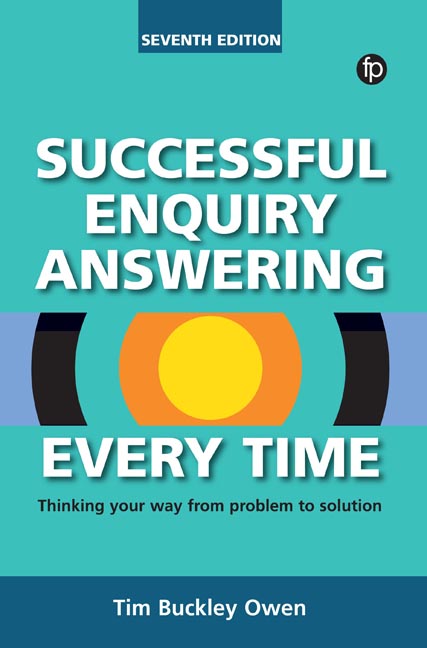Book contents
- Frontmatter
- Dedication
- Contents
- Introduction: Why thinking skills matter
- Eight essential thinking skills for successful enquiry answering
- 1 What do they really want? Using your analytical thinking skills to understand the question
- 2 Why remote enquiry handling is different Anticipating problems by thinking empathetically
- 3 Getting started Dealing with the panic by thinking imaginatively
- 4 Smarter searching Developing efficient search strategies by thinking systematically
- 5 Help! Everything's going wrong Using lateral thinking to get out of difficulties
- 6 Success! Now let's add some value Using your creative thinking skills to present your answer well
- 7 Don't just give me another reading list! Using critical thinking skills to add further value to your answer
- 8 Choosing your toolkit Using your predictive thinking skills to determine the resources you'll need
- Index
- Miscellaneous Endmatter
2 - Why remote enquiry handling is different Anticipating problems by thinking empathetically
Published online by Cambridge University Press: 08 June 2018
- Frontmatter
- Dedication
- Contents
- Introduction: Why thinking skills matter
- Eight essential thinking skills for successful enquiry answering
- 1 What do they really want? Using your analytical thinking skills to understand the question
- 2 Why remote enquiry handling is different Anticipating problems by thinking empathetically
- 3 Getting started Dealing with the panic by thinking imaginatively
- 4 Smarter searching Developing efficient search strategies by thinking systematically
- 5 Help! Everything's going wrong Using lateral thinking to get out of difficulties
- 6 Success! Now let's add some value Using your creative thinking skills to present your answer well
- 7 Don't just give me another reading list! Using critical thinking skills to add further value to your answer
- 8 Choosing your toolkit Using your predictive thinking skills to determine the resources you'll need
- Index
- Miscellaneous Endmatter
Summary
‘Please listen carefully to the following three options: To annoy the customer, press 1; to waste everybody's time, press 2; to lose business, press 3.’
Up to now we've been assuming that your encounter with the enquirer has been face to face; we've learned quite a bit about what can go wrong if you don't anticipate potential misunderstandings and be ready to deal with them before they happen. But at least you've had plenty of other clues – besides what you and the enquirer actually say to one another – to reinforce your suspicion that things might be going wrong.
You might detect a pained expression flitting across the enquirer's face as they realize that they're not getting their needs across. They might be drumming their fingers with impatience at the lack of progress, or standing with their arms akimbo as if to demand an explanation. Or they might be avoiding eye contact with you – indicating, perhaps, that they have something to hide or, worse, that they don't have confidence in your ability to help them.
When you observe ‘tells’ like this, that does at least give you an opportunity to take remedial action. But when you can't see, and sometimes can't even hear, your enquirer, you have none of these clues to draw upon, and that means that even more things can go wrong than we encountered in Chapter 1.
As the quote at the start of this chapter indicates, remote contact centres tend to have a pretty terrible reputation. But when you do encounter a good one, you'll find it leads the way in high-quality customer service. That lesson applies just as much to information services as it does to those provided by banks, travel firms or IT helpdesks. Like them or loathe them, people are expecting more and more of the services they need to be delivered remotely.
They may be students who want instant guidance from their university resource centre before embarking on their own literature search online.
- Type
- Chapter
- Information
- Successful Enquiry Answering Every TimeThinking your way from problem to solution, pp. 27 - 46Publisher: FacetPrint publication year: 2017



